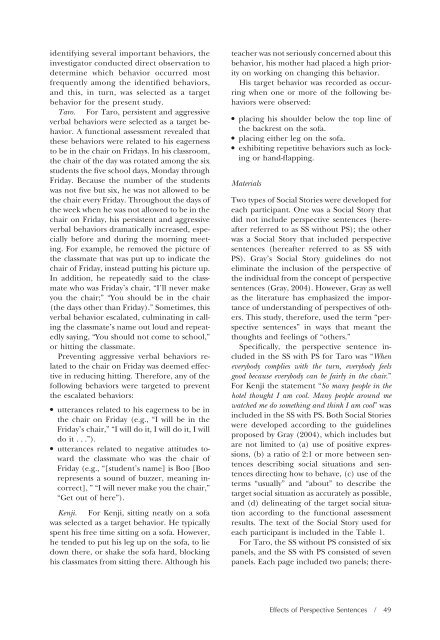Download the Journal (PDF) - Division on Autism and ...
Download the Journal (PDF) - Division on Autism and ...
Download the Journal (PDF) - Division on Autism and ...
You also want an ePaper? Increase the reach of your titles
YUMPU automatically turns print PDFs into web optimized ePapers that Google loves.
identifying several important behaviors, <str<strong>on</strong>g>the</str<strong>on</strong>g><br />
investigator c<strong>on</strong>ducted direct observati<strong>on</strong> to<br />
determine which behavior occurred most<br />
frequently am<strong>on</strong>g <str<strong>on</strong>g>the</str<strong>on</strong>g> identified behaviors,<br />
<strong>and</strong> this, in turn, was selected as a target<br />
behavior for <str<strong>on</strong>g>the</str<strong>on</strong>g> present study.<br />
Taro. For Taro, persistent <strong>and</strong> aggressive<br />
verbal behaviors were selected as a target behavior.<br />
A functi<strong>on</strong>al assessment revealed that<br />
<str<strong>on</strong>g>the</str<strong>on</strong>g>se behaviors were related to his eagerness<br />
to be in <str<strong>on</strong>g>the</str<strong>on</strong>g> chair <strong>on</strong> Fridays. In his classroom,<br />
<str<strong>on</strong>g>the</str<strong>on</strong>g> chair of <str<strong>on</strong>g>the</str<strong>on</strong>g> day was rotated am<strong>on</strong>g <str<strong>on</strong>g>the</str<strong>on</strong>g> six<br />
students <str<strong>on</strong>g>the</str<strong>on</strong>g> five school days, M<strong>on</strong>day through<br />
Friday. Because <str<strong>on</strong>g>the</str<strong>on</strong>g> number of <str<strong>on</strong>g>the</str<strong>on</strong>g> students<br />
was not five but six, he was not allowed to be<br />
<str<strong>on</strong>g>the</str<strong>on</strong>g> chair every Friday. Throughout <str<strong>on</strong>g>the</str<strong>on</strong>g> days of<br />
<str<strong>on</strong>g>the</str<strong>on</strong>g> week when he was not allowed to be in <str<strong>on</strong>g>the</str<strong>on</strong>g><br />
chair <strong>on</strong> Friday, his persistent <strong>and</strong> aggressive<br />
verbal behaviors dramatically increased, especially<br />
before <strong>and</strong> during <str<strong>on</strong>g>the</str<strong>on</strong>g> morning meeting.<br />
For example, he removed <str<strong>on</strong>g>the</str<strong>on</strong>g> picture of<br />
<str<strong>on</strong>g>the</str<strong>on</strong>g> classmate that was put up to indicate <str<strong>on</strong>g>the</str<strong>on</strong>g><br />
chair of Friday, instead putting his picture up.<br />
In additi<strong>on</strong>, he repeatedly said to <str<strong>on</strong>g>the</str<strong>on</strong>g> classmate<br />
who was Friday’s chair, “I’ll never make<br />
you <str<strong>on</strong>g>the</str<strong>on</strong>g> chair;” “You should be in <str<strong>on</strong>g>the</str<strong>on</strong>g> chair<br />
(<str<strong>on</strong>g>the</str<strong>on</strong>g> days o<str<strong>on</strong>g>the</str<strong>on</strong>g>r than Friday).” Sometimes, this<br />
verbal behavior escalated, culminating in calling<br />
<str<strong>on</strong>g>the</str<strong>on</strong>g> classmate’s name out loud <strong>and</strong> repeatedly<br />
saying, “You should not come to school,”<br />
or hitting <str<strong>on</strong>g>the</str<strong>on</strong>g> classmate.<br />
Preventing aggressive verbal behaviors related<br />
to <str<strong>on</strong>g>the</str<strong>on</strong>g> chair <strong>on</strong> Friday was deemed effective<br />
in reducing hitting. Therefore, any of <str<strong>on</strong>g>the</str<strong>on</strong>g><br />
following behaviors were targeted to prevent<br />
<str<strong>on</strong>g>the</str<strong>on</strong>g> escalated behaviors:<br />
● utterances related to his eagerness to be in<br />
<str<strong>on</strong>g>the</str<strong>on</strong>g> chair <strong>on</strong> Friday (e.g., “I will be in <str<strong>on</strong>g>the</str<strong>on</strong>g><br />
Friday’s chair,” “I will do it, I will do it, I will<br />
do it . . .”).<br />
● utterances related to negative attitudes toward<br />
<str<strong>on</strong>g>the</str<strong>on</strong>g> classmate who was <str<strong>on</strong>g>the</str<strong>on</strong>g> chair of<br />
Friday (e.g., “[student’s name] is Boo [Boo<br />
represents a sound of buzzer, meaning incorrect],<br />
” “I will never make you <str<strong>on</strong>g>the</str<strong>on</strong>g> chair,”<br />
“Get out of here”).<br />
Kenji. For Kenji, sitting neatly <strong>on</strong> a sofa<br />
was selected as a target behavior. He typically<br />
spent his free time sitting <strong>on</strong> a sofa. However,<br />
he tended to put his leg up <strong>on</strong> <str<strong>on</strong>g>the</str<strong>on</strong>g> sofa, to lie<br />
down <str<strong>on</strong>g>the</str<strong>on</strong>g>re, or shake <str<strong>on</strong>g>the</str<strong>on</strong>g> sofa hard, blocking<br />
his classmates from sitting <str<strong>on</strong>g>the</str<strong>on</strong>g>re. Although his<br />
teacher was not seriously c<strong>on</strong>cerned about this<br />
behavior, his mo<str<strong>on</strong>g>the</str<strong>on</strong>g>r had placed a high priority<br />
<strong>on</strong> working <strong>on</strong> changing this behavior.<br />
His target behavior was recorded as occurring<br />
when <strong>on</strong>e or more of <str<strong>on</strong>g>the</str<strong>on</strong>g> following behaviors<br />
were observed:<br />
● placing his shoulder below <str<strong>on</strong>g>the</str<strong>on</strong>g> top line of<br />
<str<strong>on</strong>g>the</str<strong>on</strong>g> backrest <strong>on</strong> <str<strong>on</strong>g>the</str<strong>on</strong>g> sofa.<br />
● placing ei<str<strong>on</strong>g>the</str<strong>on</strong>g>r leg <strong>on</strong> <str<strong>on</strong>g>the</str<strong>on</strong>g> sofa.<br />
● exhibiting repetitive behaviors such as locking<br />
or h<strong>and</strong>-flapping.<br />
Materials<br />
Two types of Social Stories were developed for<br />
each participant. One was a Social Story that<br />
did not include perspective sentences (hereafter<br />
referred to as SS without PS); <str<strong>on</strong>g>the</str<strong>on</strong>g> o<str<strong>on</strong>g>the</str<strong>on</strong>g>r<br />
was a Social Story that included perspective<br />
sentences (hereafter referred to as SS with<br />
PS). Gray’s Social Story guidelines do not<br />
eliminate <str<strong>on</strong>g>the</str<strong>on</strong>g> inclusi<strong>on</strong> of <str<strong>on</strong>g>the</str<strong>on</strong>g> perspective of<br />
<str<strong>on</strong>g>the</str<strong>on</strong>g> individual from <str<strong>on</strong>g>the</str<strong>on</strong>g> c<strong>on</strong>cept of perspective<br />
sentences (Gray, 2004). However, Gray as well<br />
as <str<strong>on</strong>g>the</str<strong>on</strong>g> literature has emphasized <str<strong>on</strong>g>the</str<strong>on</strong>g> importance<br />
of underst<strong>and</strong>ing of perspectives of o<str<strong>on</strong>g>the</str<strong>on</strong>g>rs.<br />
This study, <str<strong>on</strong>g>the</str<strong>on</strong>g>refore, used <str<strong>on</strong>g>the</str<strong>on</strong>g> term “perspective<br />
sentences” in ways that meant <str<strong>on</strong>g>the</str<strong>on</strong>g><br />
thoughts <strong>and</strong> feelings of “o<str<strong>on</strong>g>the</str<strong>on</strong>g>rs.”<br />
Specifically, <str<strong>on</strong>g>the</str<strong>on</strong>g> perspective sentence included<br />
in <str<strong>on</strong>g>the</str<strong>on</strong>g> SS with PS for Taro was “When<br />
everybody complies with <str<strong>on</strong>g>the</str<strong>on</strong>g> turn, everybody feels<br />
good because everybody can be fairly in <str<strong>on</strong>g>the</str<strong>on</strong>g> chair.”<br />
For Kenji <str<strong>on</strong>g>the</str<strong>on</strong>g> statement “So many people in <str<strong>on</strong>g>the</str<strong>on</strong>g><br />
hotel thought I am cool. Many people around me<br />
watched me do something <strong>and</strong> think I am cool” was<br />
included in <str<strong>on</strong>g>the</str<strong>on</strong>g> SS with PS. Both Social Stories<br />
were developed according to <str<strong>on</strong>g>the</str<strong>on</strong>g> guidelines<br />
proposed by Gray (2004), which includes but<br />
are not limited to (a) use of positive expressi<strong>on</strong>s,<br />
(b) a ratio of 2:1 or more between sentences<br />
describing social situati<strong>on</strong>s <strong>and</strong> sentences<br />
directing how to behave, (c) use of <str<strong>on</strong>g>the</str<strong>on</strong>g><br />
terms “usually” <strong>and</strong> “about” to describe <str<strong>on</strong>g>the</str<strong>on</strong>g><br />
target social situati<strong>on</strong> as accurately as possible,<br />
<strong>and</strong> (d) delineating of <str<strong>on</strong>g>the</str<strong>on</strong>g> target social situati<strong>on</strong><br />
according to <str<strong>on</strong>g>the</str<strong>on</strong>g> functi<strong>on</strong>al assessment<br />
results. The text of <str<strong>on</strong>g>the</str<strong>on</strong>g> Social Story used for<br />
each participant is included in <str<strong>on</strong>g>the</str<strong>on</strong>g> Table 1.<br />
For Taro, <str<strong>on</strong>g>the</str<strong>on</strong>g> SS without PS c<strong>on</strong>sisted of six<br />
panels, <strong>and</strong> <str<strong>on</strong>g>the</str<strong>on</strong>g> SS with PS c<strong>on</strong>sisted of seven<br />
panels. Each page included two panels; <str<strong>on</strong>g>the</str<strong>on</strong>g>re-<br />
Effects of Perspective Sentences / 49
















